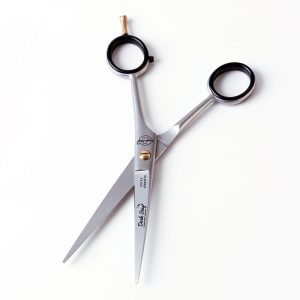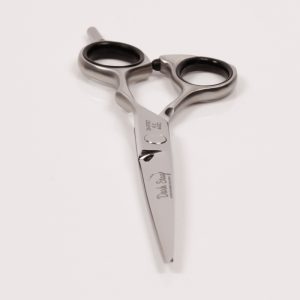Too much choice!
In the world of barbering there are many variables to the tools you use. Be it a cut throat razor or replaceable blade razor, a straight or offset handle, a synthetic or badger bristle shaving brush… there’s a lot to choose from and a lot to decide on. There’s even a lot of variation among the product types. One of the most common questions we get asked is about scissor edges, and what they mean. So we thought we’d put together this little guide to help you guys understand the difference between convex, bevel and serrated edge scissors.
Scissor blade edges
Broadly speaking, there are only 3 main types of scissor edge: bevelled, convex and serrated. There are a few other types, such as K-blade, sword blade, etc. But these aren’t quite as common and there’s probably a good reason for that. What’s the difference between these different edge types then?
Bevelled Edge
A bevelled edge, also known as a German edge, blade is a lot more durable than the other two types of edge. They are long lasting and is most likely the oldest blade design. The cutting edge is still very sharp, but the angle of the edge allows for greater durability. A bevelled edge usually requires one or both edges to be serrated, which holds the hair and prevents is from being pushed forward when cut. This type of edge is suitable for blunt cutting, but not for more advanced cutting techniques. If you find a pair of scissors made from titanium, they will be made with a bevelled edge.

Convex Edge
A convex edge is the sharpest edge you can get on a pair of scissors. They are also known by three other names: hamaguri-ba, clam shell, and most commonly, Japanese style. All convex-edged are hollow ground on the inside of the blade which gives a very smooth cutting action. They are, however, extremely fragile and can lose their edge. Applying too much forward or backward thumb pressure, or even storing your scissors loose in a drawer or dropping them will knock the edge off the scissors.
Convex scissors are perfect for any cutting technique, but excel at slide cutting, point cutting and texturising. Because the edges are so sharp, they would rub themselves dull on the hollow side of the edge. To keep this from happening, a hone line is ground in the hollow along the edge. The hone line is a thin flat line that can be sen on the hollow side of the edge that runs from the tip of the scissor to the back.

Serrated Edge
As previously mentioned, serrated blades (micro-serrated) are usually used in tandem with a bevelled edge blade. Micro-serrated blades are fantastic for when you are learning to cut hair as they prevent the hair from sliding down the blade. They’re also good for slow detail cutting or use on dry hair, but they cannot be used for slice cutting as the hair will jam on the blade. It’s also great to use for scissor over comb cutting.
Which is best?
This is a tough call to make as all of the blades are good for different reasons. Overall though, we recommend a convex edge. We recommend them for their shear (sorry not sorry) versatility with cutting techniques. You can use any technique with a convex edge scissor, unlike bevel and serrated edge scissors. Though, we would recommend any trainee barbers to start with a serrated edge first, due to the prevention of hair from sliding.
We hope you found this useful! Let us know if you have any further questions or any other topics you would like us to cover.





